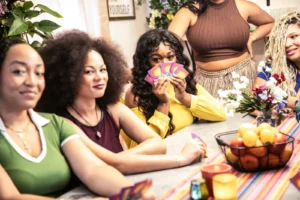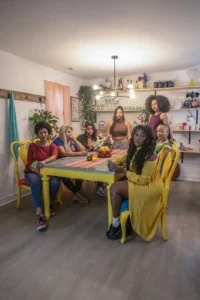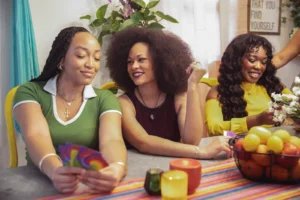From the Circle Players
For Colored Girls Who Have Considered Suicide/When the Rainbow is Enuf
Ntozake Shange’s acclaimed 1976 choreopoem For Colored Girls Who Have Considered Suicide/When the Rainbow is Enuf opened Circle Players’ 75th season. Middle Tennessee’s oldest non-profit community theatre group is committed to inclusivity and voicing underrepresented stories.
I attended the October 11th showing, and Tosha Marie, the president of the Board of Directors for Circle Players (as well as producer, choreographer & costume designer of the play) welcomed the audience at the entrance of the theater with a tissue box, hinting at the tear-jerker nature of the play. In an extensive, carefully put together 16-page program that the audience could gain access to via a QR code, she writes:
“This season, we aim to create a space for dialogue and reflection, inviting you to join us in this important work. As we celebrate 75 years of storytelling, we are grateful for your support and engagement. Together, we can create a vibrant theater community that honors our past while looking forward to a more inclusive future.” 
Ntozake Shange’s very personal tale For Colored Girls Who Have Considered Suicide/When the Rainbow is Enuf resonated with one of Nashville’s most acclaimed and brave theater directors, Cynthia Harris, who “continuously creates and performs works that capture the experiences of Black women and girls. Her preferred format is the choreopoem, which she views as a culturally specific form of performance and audience engagement, based on the work of Ntozake Shange, to authentically express the personal and social experience of Black women.”
For this staging, Harris got her inspiration and directorial vision from her childhood memories of her mother and her four aunts sitting around the kitchen table in the late 60s while lending eyes, ears, strength, and wisdom to each other’s struggles. According to Harris, this experience can and should expand beyond blood sisters, into what she calls “sister-friends.” Thus the director not only inherits Shange’s artistic expression through her preferred format of choreopoem, but also the feminist philosophy and approach to life. Interestingly enough, Harris does not borrow the dance aspect, one of the main elements of Shange’s choreopoem, although she endorses the poetic monologues and music. This absence can be read as the director’s darker vision of the condition of black and brown women: united in their voices but not fully liberated through their individual bodily freedoms of expression.
 In an Airbnb stage setting (designed by Henry Jones), the walls of which are filled with portraits of powerful and resilient black women, Harris creates a rainbow of “7 sisters reuniting in response to intimate partner violence. Their stories are shared as if they were medicine to each other, helping them to heal together through bringing up their unconditional love and support for each other. These women serve as sacred witnesses to each other’s healing and transformation.”
In an Airbnb stage setting (designed by Henry Jones), the walls of which are filled with portraits of powerful and resilient black women, Harris creates a rainbow of “7 sisters reuniting in response to intimate partner violence. Their stories are shared as if they were medicine to each other, helping them to heal together through bringing up their unconditional love and support for each other. These women serve as sacred witnesses to each other’s healing and transformation.”
The story of the play consists of women, sisters, and sister-friends who, beginning with the youngest one, feel safe to open up and connect on a natural and supernatural level. They transcend through the experiences of mythical heroines and goddesses, all having one thing in common: the beauty and burden of womanhood, the ill treatment, despotism and exploitation that still reigns in a society rendering her as an unequal member. Thus, through any layer of discrimination on the basis of identity politics, it was very easy to feel empathy with the stories that were being unfolded on stage.
In terms of mise-en-scène, every corner of the stage was fully utilized. When one of the women shared her story, the others were attentively listening, surrounding her from various angles. There were also beautiful moments of gathering in smaller groups to converge and connect. Although the performance didn’t directly invite this, the audience was often communicating their empathy, encouragement, and dismay directly, which created a warm homey atmosphere.
Among the actresses, Kristian Hardy as Green especially stood out for her stoic presence in silence, often listening to the other’s stories with full attention. For her last fragment, Nina Hibbler-Webster as Rea took everyone’s breath away.
 One major hiccup that was a distraction and worked rather against the other elements of the staging was the bad wireless microphone connection which almost sporadically switched between the actresses’ natural and amplified voices. The small theater setting would have functioned without microphones just as well, elevating the intimacy between the performers and the audience.
One major hiccup that was a distraction and worked rather against the other elements of the staging was the bad wireless microphone connection which almost sporadically switched between the actresses’ natural and amplified voices. The small theater setting would have functioned without microphones just as well, elevating the intimacy between the performers and the audience.
During the post premiere talk, in the presence of the seven actresses, Harris spoke of the audition, the rehearsals and of giving space to them to both find their inner voices and connection with their characters, as well as to form a bond with their sister-friends to grow in harmony while embracing their diversities in appearance, style, approaches to life and challenges they face.
By the edge of the blade, both the choreopoem and the staging carried the danger of villainizing all men, particularly the black cis men, until the last monologue where the brutal actions of the perpetrator became related to his loss of sensitivity and the trauma from serving in the army and experiencing the brutality of war, thus raising the issue to a bigger picture, that of the systemic instrumentalization and oppression.
Overall, the performance grew in me as it unfolded the layers of these seven unique women, representing a rainbow, a grain of hope, an aspiration to dream for a better future, only if in that dream we are all equal, while unique and understanding the importance of coexisting as a way of fulfilling one another.
This production’s run is over, but Circle Players’ 75th season continues with And the World Goes Round in the winter. For more information, see Circle Players.


